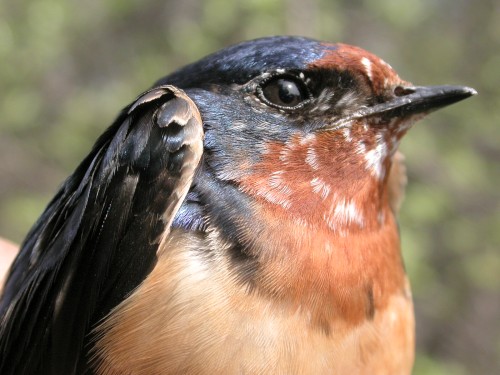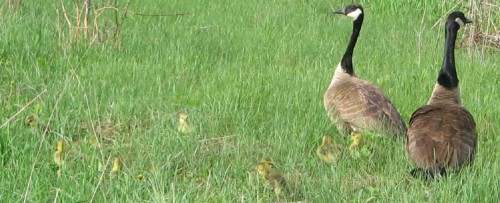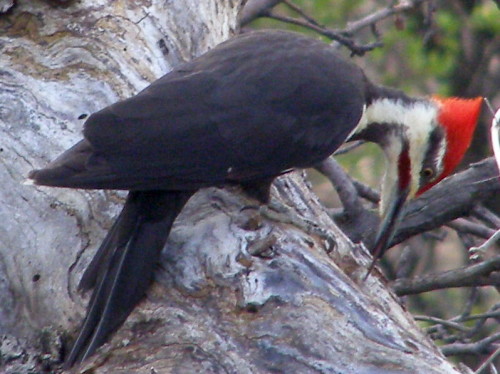|
McGILL BIRD OBSERVATORY |
||||||||||||||||||||||||||||||||||||||||||||||||||||||||||||||||||||||
Welcome
to the McGill Bird Observatory weekly report.
Click here for a complete listing of our archives.
Banders-in-charge:
Marcel Gahbauer, Marie-Anne Hudson, Barbara Frei Notes: Weather continues to be a major influence on our observations, only this week it was in the form of several rainy days, rather than the persistent north winds we were experiencing until recently. As a result, while no day was entirely rained out, our banding effort for the week was curtailed considerably. As the rain was generally cold, it didn't even bring in much in the way of new migrants. So, while it is now mid-May, and many species have started to trickle in slowly, we have yet to observe even a moderately impressive wave of passerine migration this year. However, the apple trees are now in full bloom and the rest of the vegetation is growing at a tremendous rate thanks to the rain, so it is feeling very much like spring even if the bird song isn't quite up to par yet. The list of 18 new species that did arrive over the past week is an eclectic one. Our first Rough-legged Hawk of spring was perhaps the biggest surprise, as they are usually a very early migrant. Passing overhead later the same morning were another Golden Eagle and a Bald Eagle being attacked by a Merlin, so it had company among the late raptor migrants. Other new species included 8 more species of warbler, plus Northern Shoveler, Spotted Sandpiper, Ruby-throated Hummingbird, Least Flycatcher, Great-crested Flycatcher, and Bobolink. For the week, we observed 85 species, with a single-day high of 55 on Monday. While it was overall still a rather quiet week, the raptor flight was just one of several memorable moments. Another particularly remarkable one occurred on Tuesday morning, when a Barn Swallow flew in through the open door of the banding station while we were inside processing a Song Sparrow! No doubt it was exploring potential nesting sites, but when it saw us inside it was startled and flew into one of the windows. Fortunately it was only momentarily stunned, and so we banded it before releasing it back outside ... at least if this one comes back we'll be able to recognize him! It became our 95th species banded at MBO - see the updated checklist for current totals.
Quiz time ... how many goslings in the photo below? The Canada Geese have produced the first young birds of the year at MBO, with their goslings being spotted for the first time on Saturday morning. It appears that while we were fixated on the unsuccessful roof-nesting goose in the back pond, another much more secretive pair was on a nest in Stoneycroft Pond. Also this week we noticed the first eggs of the year in the nest boxes (only House Sparrows so far), and there are active Northern Cardinal, Red-winged Blackbird, and American Robin nests under observation as well. Based on the documentation of brood patches during banding, it appears that at least a few Common Grackles and Song Sparrows have begun to nest too. Our banding rate was similar to last week, but the totals were down due to the rain. Red-winged Blackbirds yet again were the most frequently banded species, bringing their season total to 124 (just over 25% of our season total of all birds!). Common Grackles remained common too, and we continued to band modest numbers of American Goldfinch and White-throated Sparrow. Most of the rest of this week's top ten are new arrivals, including three species of warbler, plus Rose-breasted Grosbeak, Baltimore Oriole, and Tree Swallow.
There was considerable turnover this week in the species most frequently observed. The Canada Goose migration came to an abrupt end late last week, and with only the resident two pairs around this week, they dropped entirely out of the top ten. Ring-billed Gull numbers barely changed since last week, but they became the most numerous species this week with the disappearance of the Canada and Snow Goose flocks. A few Cliff Swallows were seen last week already, but this week numbers shot up as they were attracted to a hatch of midges over Stoneycroft Pond midweek. Common Grackle numbers are tapering off a bit, but surprisingly Red-winged Blackbirds continue to increase, and small flocks of migrants are still being seen. White-throated Sparrows and Ruby-crowned Kinglets largely disappeared this week, while Yellow Warblers and American Goldfinches have increased enough to break into this week's top ten. Again, not a single Cedar Waxwing was seen all week - will they show up at all this spring? Also notable for being overdue are Common Yellowthroats (here by May 7 last year), as well as Pied-billed Grebe and Chimney Swift, both of which were being seen regularly by mid-May in 2005. Hopefully they will all soon turn up.
|




 -
-